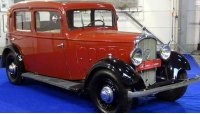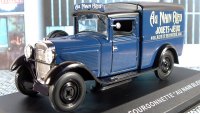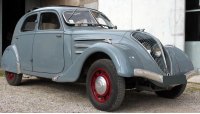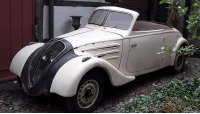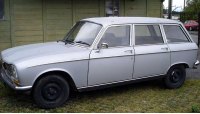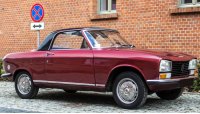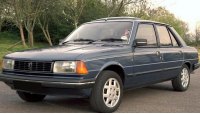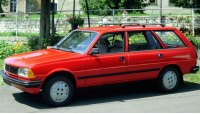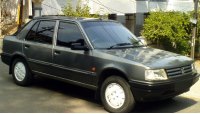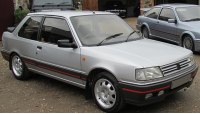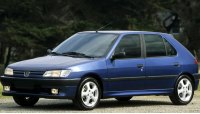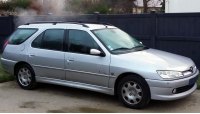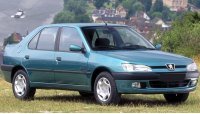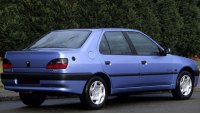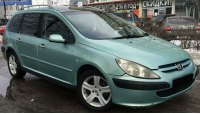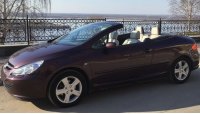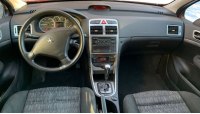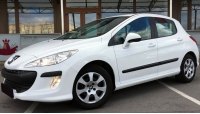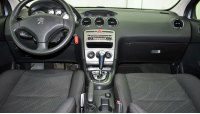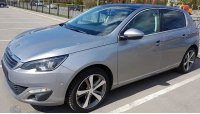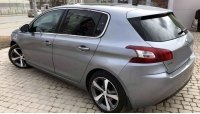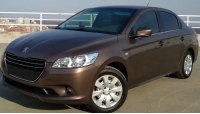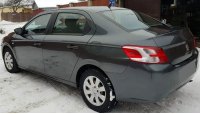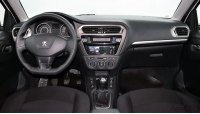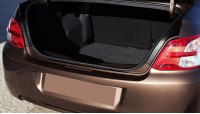Share information:
Peugeot 301 (1932-1936)
Peugeot 301 — passenger mid-size family car (D-segment), produced by the French automaker «Peugeot» from 1932 to 1936 as a replacement for obsolete «Type 177». Built on a successful «Peugeot 201», which has been produced since 1929. This is one of the first mass-produced cars in the world with independent front suspension, with leaf springs at the rear, standard for that time. The engine was located longitudinally in front, rear-wheel drive, which was also then the standard. Brakes are all drum with cable drive.
The body was produced as a four-door sedan (with six windows, three on each side), two-door convertible or coupe, and three-door van (double, commercial). Standard length with regular wheelbase (2720 mm) was 4000 mm, width 1440-1600 mm and height 1480 mm. There was also an extended wheelbase (2940 mm), while the total length of the car reached 4800 mm. In just four years, more than 70 thousand copies were produced.
The engine was a petrol four-cylinder water-cooled 1.5 liter (1465 cm3) 35 hp. Transmission three-speed manual without synchronizers. Depending on the body, the car had a maximum speed of 80-100 km / h.
Peugeot 302 (1936-1938)
Peugeot 302 - French compact family car (C-segment), which was produced for only 18 months from November 1936 to April 1938 due to the unstable political and economic situation in the country. It was shown to the public in October 1936. Was technically and design almost identical «Peugeot 402», but with a smaller engine and a shorter body. The bulk of the cars were four-door sedans, there were also two-door convertibles and coupes, as well as a small number of roadsters and convertibles with an automatic steel roof. The length of the car was 4500 mm, the width was 1570 mm and the curb weight was 1110 kg. In total, about 25 thousand cars were produced.
The engine was located longitudinally in front, the transmission of torque was carried out to the rear wheels through a three-speed manual gearbox and a driveshaft and differential in the rear axle. The engine was a 1.8-liter four-cylinder gasoline (1758 cm3, TE) 43 hp. Power carburetor, water cooling. The maximum speed was 105 km / h. The front suspension was independent, which first appeared on «Peugeot 201» in 1931 and quickly gained popularity due to its improved traction and better handling.
Peugeot 304 (1969-1980)
Peugeot 304 - small family car (C-segment) French company «Peugeot», which was produced from 1969 to 1980. It was shown to the public at the 56th Paris Motor Show in October 1969. Platform based «Peugeot 204». The design of the car was developed by the Italian design firm «Carrozzeria Pininfarina» and not much different from cars «Peugeot» other classes produced at that time. The most important innovation is the transition from rear-wheel drive to front-wheel drive with a transverse engine. Competitors «304» at that time in this segment were «Citroën GS» and cheaper «Renault 12». For all the time of release, the car has not changed much. In total, more than 1.1 million copies were produced.
Body options were as follows - four-door sedan (length 4140 mm, width 1570 mm, height 1410 mm), five-door station wagon (length 3990 mm, width 1570 mm, height 1430 mm), two-door coupe and convertible (length 3760 mm, width 1570 mm, height 1320 mm), as well as a three-door van (length 4010 mm, width 1570 mm, height 1430 mm). The curb weight of the car was 890-970 kg. The engine was originally a 1.3-liter gasoline four-cylinder (1288 cm3, SOHC), model «XL3» 65 hp, and in 1975 it was modified, the model became «XL5», which increased the torque at the same power of 65 hp. Also, a double carburetor was installed on the engines, which increased the power to 75 hp. Since July 1976, a 1.4-liter four-cylinder diesel engine has become available (1357 cm3) 44 hp. The gearbox was a mechanical four-speed.
Peugeot 305 (1977-1989)
Peugeot 305 - French family compact car (C-segment), which is produced from November 1977 to 1989 by the company «Peugeot». The design of the car was developed by an Italian company «Pininfarina», was very different from its predecessor and outwardly resembled BMW 3 seriesand that time. Throughout Europe, it competed with cars such as Audi 80, Ford Cortina, Ford Escort, Ford Taunus, Opel Ascona, Opel Kadett, Renault 18, Nissan Bluebird, Simca 1307, Volkswagen Golf. In 1979, an authoritative British magazine «What Car?» awarded the 305th title «Car of the Year». The body was a four-door sedan (length 4242 mm, width 1630 mm, height 1380 mm), five-door station wagon (length 4260 mm, width 1641 mm, height 1425 mm) and a three-door van.
Vehicle safety has been improved with the introduction of front and rear crumple zone technology, side impact protection and a protected fuel tank. In 1981, serious work was done on the aerodynamics of the body, which led to a decrease in the drag coefficient from 0.44 to 0.32. The rear suspension has become fully independent with trailing arms and shock absorbers, MacPherson type in front. This suspension configuration would become standard for many years to come in this class of vehicle.
All engines were four-cylinder with a front transverse arrangement, the drive was on the front wheels. There were four 1.3-liter petrol engines (1290 cm3, XL5, 60 hp), 1.5 liters (1472 cm3, XR5/XR5S, 68/88 hp), 1.6 liters (1580 cm3, XU5, 90 hp) and 1.9 liters (1905 cm3, XU9, 102 hp). There were two modifications of diesel engines with a volume of 1.5 liters (1548 cm3, XIDL, 49 hp) and 1.9 liters (1905 cm3, XUD9, 65 hp). The gearbox is a four-speed manual, and for the first time they began to install a four-speed automatic.
Peugeot 309 (1985-1994)
Peugeot 309 - family compact car (C-segment) French automaker «Peugeot», produced from October 1985 to 1994. Intended to designate brand cars «Talbot», but in 1985 this brand was decided to be abolished. Custom Model Number «309» instead of next logical number «306», following the previous generation «305», made in order to somewhat separate this one from larger cars «305», which were produced in parallel until 1989. The body was only a three- or five-door hatchback with a length of 4050 mm, a width of 1630 mm, a height of 1380 mm and a curb weight of 835 kg. The assembly of the car was carried out in France, Great Britain, Spain and India.
At first, gasoline engines installed production «Simca Poissy» 1.1 liter (1118 cm3, E1A, 50 hp) and 1.3 liters (1294 cm3, G1A, 81 hp), as well as production «Peugeot» 1.6 liters (1580 cm3, XU5, 79 hp) and 1.9 liters (1905 cm3, XU9, 104-146 hp). Diesel engines were also four-cylinder 1.8-liter (1769 cm3, XUD7, 59 hp) and 1.9 liters (1905 cm3, XUD9, 64 hp). The transmission was a four- or five-speed manual, as well as a three- or four-speed automatic.
In the summer of 1989, the model was updated. The front part of the body and the radiator grille, taillights, trunk lid, as well as interior design were changed. Gasoline engines began to change to new series «TU» 1.1 liter (1124 cm3, TU1, 59 hp) and 1.4 liters (1360 cm3, TU3, 74 hp).
Peugeot 306 (1993-2002)
Peugeot 306 - small family car (C-segment) French company «Peugeot», which was produced from March 1993 to 2002. They seriously worked on the design so as not to yield, but in some ways to surpass competitors. The technical part was identical «Citroën ZX», which was released two years earlier. The body shape was in the form of a three- or five-door hatchback (length 4030 mm, width 1680 mm, height 1380 mm), four-door sedan (length 4267 mm, width 1680 mm, height 1386 mm), five-door station wagon (length 4338 mm, width 1680 mm, height 1415 mm) and a two-door convertible. The curb weight of the car was 980 kg. The trim levels were «XN», «XL», «XR», «XT» And «XS». The letter was added to the names of diesel models «d» or «dt» (turbodiesel). Assembly was carried out in France, Argentina, Great Britain, Uruguay and Chile. In total, about 2.9 million cars were produced.
Phase 1
Initially, eight-valve four-cylinder gasoline engines of the series «TU», which have already been tested for «205», «309» And «405»: 1.1 liters (1124 cm3, TU1, 59 hp), 1.4 liters (1360 cm3, TU3, 74 hp) and 1.6 liters (1587 cm3, TU5, 89 hp). Later, 16-valve engines of the series were added «XU» 1.8 liters (1761 cm3, XU7, 102 hp) and 2.0 liters (1998 cm3, XU10, 121/155/165 hp). Diesel engines series «XUD» have earned a good reputation and were installed with a volume of: 1.8 liters (1769 cm3, XUD7, 59 hp) and 1.9 liters (1905 cm3, XUD9), atmospheric with a capacity of 68-73 hp, and with a turbocharger with a capacity of 90 hp. The transmission was a five- or six-speed manual, as well as a four-speed automatic.
Phase 2
In May 1997, a major update was made called «Phase 2». The exterior lighting fixtures, grille and bumpers have been redesigned to bring the design in line with the new, more rounded appearance, which appeared for the first time on «Peugeot 406». The interior has also been upgraded and the quality of the interior trim has been improved. A wagon body was also added.
All petrol and diesel engines remained the same with some improvements, only the weak 1.1-liter engine was removed.
Phase 3
In 1999, another update to the car was carried out, which brought transparent lenses on the headlights, round transparent fog lamps, removed the black stripe on the tailgate, added new body colors, as well as other less noticeable exterior changes and minor interior changes. Gasoline engines remained unchanged, and instead of the outdated diesel series «XUD» installed a new series «HDi» with fuel injection «Common Rail» 2.0 liters (1997 cm3) 89 hp. Almost all models have «ABS» and multiple airbags as standard equipment. Production ended in 2001, sales continued until 2002.
In 1998 the European Committee «Euro NCAP» Subjected the vehicle to crash tests to determine its safety, rated adult occupant safety 3 stars out of 5 and pedestrian safety 1 star out of 5.
Peugeot 307 (2001-2008)
Peugeot 307 - compact family car (C-segment), which was produced by a French company «Peugeot» from April 2001 to 2008, and in some countries (Argentina, China) produced until 2014. It was shown to the public in October 2000 at the Paris Motor Show. Platform based «PSA PF2», which was also used for «Citroën C4», «Citroën DS4», «DongFeng H30 Cross», «Peugeot 308», «Peugeot 3008», «Peugeot RCZ» and others. In total, about 3.7 million cars were produced. European Prize «Car of the Year» (international award from the team of European auto magazines) was assigned «307» in 2002. Popular British magazine «Top Gear» praised the car for price, space, handling and running costs, placing it above the competition - «Ford Focus» And «Honda Civic».
The body was produced as a three- and five-door hatchback (length 4210 mm, width 1730 mm, height 1510 mm), five-door station wagon «307SW» (length 4420 mm, width 1730 mm, height 1510 mm), four-door sedan (length 4470 mm, width 1730 mm, height 1510 mm) and two-door coupe-cabriolet «307CC» with retractable hardtop (length 4350 mm, width 1730 mm, height 1420 mm). The curb weight of the car was 1140-1360 kg.
In June 2005, the model was updated, which affected the headlights, hood, grille, front bumper.
The range of gasoline four-cylinder engines was as follows:
- 1.4 liters (1360 cm3, TU3) 74 hp
- 1.4 liters (1360 cm3, ET3) 89 hp
- 1.6 liters (1587 cm3, TU5) 108 hp
- 2.0 liters (1997 cm3, EW10) 138 or 175 hp
Diesel engines were also all four-cylinder:
- 1.4 liters (1398 cm3, DV4 HDi) 68 hp
- 1.6 liters (1560 cm3, DV6 HDi) 89-108 hp
- 2.0 liters (1997 cm3, DW10 HDi) 134 hp
- 2.0 liters (1997 cm3, HDI) 89 hp
The gearbox was installed five- and six-speed manual or four-speed automatic.
Peugeot 308 (2007-present time)
First generation (T7)
Peugeot 308 - compact French family car (C-segment), which is produced from September 2007 to the present by the automaker «Peugeot». Based on the same chassis «PSA PF2», What «307», but with a new body with a drag coefficient of 0.29. Body options were as follows - a three- or five-door hatchback (length 4276 mm, width 1815 mm, height 1498 mm), four-door sedan, five-door station wagon «308SW» (4500 mm, width 1815 mm, height 1564 mm) and two-door coupe-cabriolet «308CC» (length 4440 mm, width 1817 mm, height 1426 mm). The curb weight was 1387-1521 kg. The car was assembled in France, Argentina, Indonesia, China and Malaysia. At the moment there are two generations of this model. The first generation produced more than 1.2 million vehicles.
Four-cylinder gasoline engines were installed with the following characteristics - 1.4 liters (1397 cm3, Prince EP3, 94 hp), 1.6 liters (1598 cm3, Prince EP6, 118 hp) and 1.6 liters (1598 cm3, Prince EP6DT, turbocharged, 148 hp). Diesel engines were also four-cylinder 1.6-liter (1560 cm3, DV6 ATED4, 89 hp), 1.6 liters (1560 cm3, DV6 TED4, hp) and 2.0 liters (1997 cm3, DW10 BTED4, 136 hp). Automobile «308 HDi» with a diesel engine still holds the record in «Guinness Book of Records» for the smallest average fuel consumption of 3.13 liters per 100 km. The transmission was a six- or five-speed manual, as well as a six-speed automatic or semi-automatic.
In May 2011, the model was updated, presenting it at the same year at the Geneva Motor Show. The front part has changed quite a lot, the back part has changed slightly. A car was also released «308 e-HDI» with technology «start-stop», a braking energy recovery system and a hybrid battery that provides additional energy when starting. For South America in 2015, a second restyling was carried out.
European Committee «EuroNCAP» tested a five-door hatchback in 2007 and a two-door convertible in 2008, see the results in the tables below.

Second generation (T9)
The second generation was introduced in the fall of 2013, when the design was updated simultaneously with the new models «208» And «508». Model number «308» was fixed and became the main one, and for emerging markets (Asia, Africa, Latin America, Eastern Europe) a car was produced with the name «Peugeot 301». From that moment on, the numbering was fixed, that is, there will not be a new numbering with the release of the next generation, but there will be generations, like most automakers. Both models are based on the new platform «PSA EMP2», resulting in a total weight reduction of more than 100 kg. The body was produced as a five-door hatchback (length 4253 mm, width 1804 mm, height 1457 mm) and station wagon (length 4585 mm, width 1804 mm, height 1472 mm), as well as a four-door sedan. The curb weight was 1060-1320 kg. All headlights are equipped with daytime running lights. The production of the car was in France, China and Malaysia.
Gasoline engines were four-cylinder, and also for the first time began to use three-cylinder in-line engines with a volume of 1.2 liters (1199 cm3, VTi, I3, 82 hp), 1.2 liters (1199 cm3, e-THP, PureTech, I3, turbocharged, 110/130 hp) and 1.6 liters (1598 cm3, THP, Prince, I4, turbocharged, 125/155/205/250/270 hp). Diesel engines were installed four-cylinder of the following characteristics - 1.6 liters (1560 cm3, HDi, 92 hp), 1.6 liters (1560 cm3, e-HDi, 115 hp), 1.6 liters (1560 cm3, BlueHDi, 100/120 hp) and 2.0 liters (1997 cm3, BlueHDi, DW10B, 150/180 hp). All diesels are turbocharged. The gearbox is a five- or six-speed manual, as well as a six- or eight-speed automatic.

Second generation «Peugeot 308» has been crash tested by the European Committee «EuroNCAP» in 2013, the results of which are shown in the table on the right.
Currently, the main competitors and classmates of the Peugeot 308 are the following cars: Audi A3, BMW 1 series, Fiat Bravo, Chevrolet Cruze, Chery Bonus, Citroën C4, Ford Focus, Honda Civic, Hyundai Elantra, Infiniti Q30, Kia ceed, Kia Cerato, Mazda 3 (Familia), Lada Samara, Lada Vesta, Lifan Breez, Mercedes A-Class (W177), Mitsubishi Lancer, Nissan Almera, Nissan Sentra, Opel Astra (Kadett), Renault Megane, SEAT Leon, Skoda Octavia, Subaru Impreza, Toyota Auris, Toyota Corolla, Toyota Allion and Volksvagen Golf.
Peugeot 301 (2012-present time)
Peugeot 301 - compact car (C-segment), produced by a French company «Peugeot» from 2012 to present for emerging economies and not available in Western Europe. It was presented to the public at the Paris Motor Show in October 2012. Index «301» already used in 1932 and produced in parallel with «Peugeot 308» second generation. The body is only a four-door sedan with a length of 4442 mm, a width of 1748 mm, a height of 1466 mm and a curb weight of 1055 kg. Has three trim levels - «Access», «Active» And «Allure». The car is produced in Spain, Iran, China and Nigeria. Model «301» there is almost a complete analogue «Citroën C-Elysée».
There were three modifications of gasoline engines with a volume of 1.2 liters (1199 cm3, VTi, I3, 71 hp), 1.2 liters (1199 cm3, puretech, I3, hp) and 1.6 liters (1587 cm3, VTi, I4, hp). Diesel engines were two models, both four-cylinder 1.6-liter (1560 cm3), one motor «HDi» 91 hp and second «blueHDi» 99 hp. The transmission is a five-speed automatic and a four- or six-speed automatic.
Front suspension independent type «MacPherson» with springs and a transverse stabilizer, rear semi-independent with springs and the same stabilizer. Front ventilated disc brakes, drum rear.

In 2014 the car was tested by the European committee «Euro NCAP» for safety, see the crash test results in the table.

